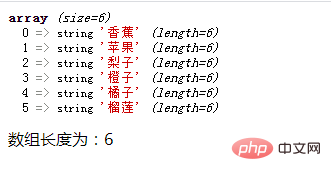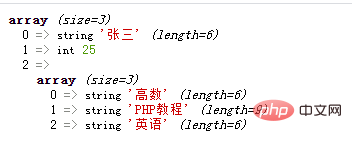 Backend Development
Backend Development
 PHP Tutorial
PHP Tutorial
 PHP array learning two-dimensional array calculation array length
PHP array learning two-dimensional array calculation array length
PHP array learning two-dimensional array calculation array length
In the previous article "PHP Array Learning: A Brief Analysis of Two-Dimensional Array Creation Methods", we introduced how to create two-dimensional arrays (multi-dimensional arrays). If you are interested, you can take a look. Now that we have an array, we need to operate it. Sometimes we need to know the length of the array (the number of all elements in the array). So how to get the array length of a two-dimensional array or even a multi-dimensional array? Today we are here to learn about it with you.
We know how to get the array length of a one-dimensional array. It's very simple. Just use count($arr).
<?php
header("Content-type:text/html;charset=utf-8");
$arr= array("香蕉","苹果","梨子","橙子","橘子","榴莲");
//输出语句
var_dump($arr);
echo "数组长度为:".count($arr);
?>Output result:

# Is it very simple, what about the two-dimensional array? How to calculate the length of a two-dimensional array or even a multi-dimensional array and count the number of elements?
Two-dimensional arrays are also simple. We still use the count() function. We only need to pass two parameters to the count() function: the first parameter is $array as above, specifying the array to be counted; and the second parameter is $array as above, specifying the array to be counted; The two parameters are $mode, and the value is set to COUNT_RECURSIVE or 1, so that the count() function will recursively calculate the number of elements in the array.
Let’s use two code examples to learn more about how to use the count() function to pass the array length of a multi-dimensional array.
Example 1: The length of the two-dimensional array
<?php
header("Content-type:text/html;charset=utf-8");
$arr= array
("张三",
25,
array("高数","PHP教程","英语"),
);
//输出语句
echo "数组长度为:".count($arr,1);
?>Output:
数组长度为:6
Looking at the above output, it is No need to be confused, there are not only 5 elements in the array ("张三"、25、"高书"、"PHP tutorial", "English"), why is the array length displayed in the result not 5, but 6?
In fact, this is because at this time, the count() function loops to count all elements in the two-dimensional array, "array("高num","PHP Tutorial","English")" It will be counted once as a whole, and the elements inside it ("高书", "PHP Tutorial", "English") will be counted again. , so the final result is 6.
We output the $arr array through the var_dump() function and look at its data structure. We can intuitively understand the process of the count() function.

Example 2: Length of three-dimensional array
<?php
header("Content-type:text/html;charset=utf-8");
$arr = array(
'安徽' => array(
'合肥'=>array('蜀山区','长丰县','肥东'),
'宿州'=>array('墉桥区','灵璧县','泗县')
),
'河南' => array(
'洛阳'=>array('西工区','老城区','孟津县'),
'郑州市'=>array('中原区','金水区')
)
);
var_dump($arr);
echo "数组长度为:".count($arr,1);
?>Output result:

Extended knowledge:
In addition to using the count() function to calculate the array length, we can also use the sizeof() function. The sizeof() function is an alias of the count() function, and its function and usage are exactly the same as the count() function.
Okay, that’s all. If you want to know anything else, you can click this. → →php video tutorial
Finally, I would like to recommend a free video tutorial on PHP arrays: PHP function array array function video explanation, come and learn!
The above is the detailed content of PHP array learning two-dimensional array calculation array length. For more information, please follow other related articles on the PHP Chinese website!

Hot AI Tools

Undresser.AI Undress
AI-powered app for creating realistic nude photos

AI Clothes Remover
Online AI tool for removing clothes from photos.

Undress AI Tool
Undress images for free

Clothoff.io
AI clothes remover

Video Face Swap
Swap faces in any video effortlessly with our completely free AI face swap tool!

Hot Article

Hot Tools

Notepad++7.3.1
Easy-to-use and free code editor

SublimeText3 Chinese version
Chinese version, very easy to use

Zend Studio 13.0.1
Powerful PHP integrated development environment

Dreamweaver CS6
Visual web development tools

SublimeText3 Mac version
God-level code editing software (SublimeText3)

Hot Topics
 1672
1672
 14
14
 1428
1428
 52
52
 1332
1332
 25
25
 1277
1277
 29
29
 1257
1257
 24
24
 PHP: A Key Language for Web Development
Apr 13, 2025 am 12:08 AM
PHP: A Key Language for Web Development
Apr 13, 2025 am 12:08 AM
PHP is a scripting language widely used on the server side, especially suitable for web development. 1.PHP can embed HTML, process HTTP requests and responses, and supports a variety of databases. 2.PHP is used to generate dynamic web content, process form data, access databases, etc., with strong community support and open source resources. 3. PHP is an interpreted language, and the execution process includes lexical analysis, grammatical analysis, compilation and execution. 4.PHP can be combined with MySQL for advanced applications such as user registration systems. 5. When debugging PHP, you can use functions such as error_reporting() and var_dump(). 6. Optimize PHP code to use caching mechanisms, optimize database queries and use built-in functions. 7
 PHP and Python: Comparing Two Popular Programming Languages
Apr 14, 2025 am 12:13 AM
PHP and Python: Comparing Two Popular Programming Languages
Apr 14, 2025 am 12:13 AM
PHP and Python each have their own advantages, and choose according to project requirements. 1.PHP is suitable for web development, especially for rapid development and maintenance of websites. 2. Python is suitable for data science, machine learning and artificial intelligence, with concise syntax and suitable for beginners.
 PHP in Action: Real-World Examples and Applications
Apr 14, 2025 am 12:19 AM
PHP in Action: Real-World Examples and Applications
Apr 14, 2025 am 12:19 AM
PHP is widely used in e-commerce, content management systems and API development. 1) E-commerce: used for shopping cart function and payment processing. 2) Content management system: used for dynamic content generation and user management. 3) API development: used for RESTful API development and API security. Through performance optimization and best practices, the efficiency and maintainability of PHP applications are improved.
 The Enduring Relevance of PHP: Is It Still Alive?
Apr 14, 2025 am 12:12 AM
The Enduring Relevance of PHP: Is It Still Alive?
Apr 14, 2025 am 12:12 AM
PHP is still dynamic and still occupies an important position in the field of modern programming. 1) PHP's simplicity and powerful community support make it widely used in web development; 2) Its flexibility and stability make it outstanding in handling web forms, database operations and file processing; 3) PHP is constantly evolving and optimizing, suitable for beginners and experienced developers.
 PHP and Python: Different Paradigms Explained
Apr 18, 2025 am 12:26 AM
PHP and Python: Different Paradigms Explained
Apr 18, 2025 am 12:26 AM
PHP is mainly procedural programming, but also supports object-oriented programming (OOP); Python supports a variety of paradigms, including OOP, functional and procedural programming. PHP is suitable for web development, and Python is suitable for a variety of applications such as data analysis and machine learning.
 PHP vs. Other Languages: A Comparison
Apr 13, 2025 am 12:19 AM
PHP vs. Other Languages: A Comparison
Apr 13, 2025 am 12:19 AM
PHP is suitable for web development, especially in rapid development and processing dynamic content, but is not good at data science and enterprise-level applications. Compared with Python, PHP has more advantages in web development, but is not as good as Python in the field of data science; compared with Java, PHP performs worse in enterprise-level applications, but is more flexible in web development; compared with JavaScript, PHP is more concise in back-end development, but is not as good as JavaScript in front-end development.
 PHP and Python: Code Examples and Comparison
Apr 15, 2025 am 12:07 AM
PHP and Python: Code Examples and Comparison
Apr 15, 2025 am 12:07 AM
PHP and Python have their own advantages and disadvantages, and the choice depends on project needs and personal preferences. 1.PHP is suitable for rapid development and maintenance of large-scale web applications. 2. Python dominates the field of data science and machine learning.
 PHP: Handling Databases and Server-Side Logic
Apr 15, 2025 am 12:15 AM
PHP: Handling Databases and Server-Side Logic
Apr 15, 2025 am 12:15 AM
PHP uses MySQLi and PDO extensions to interact in database operations and server-side logic processing, and processes server-side logic through functions such as session management. 1) Use MySQLi or PDO to connect to the database and execute SQL queries. 2) Handle HTTP requests and user status through session management and other functions. 3) Use transactions to ensure the atomicity of database operations. 4) Prevent SQL injection, use exception handling and closing connections for debugging. 5) Optimize performance through indexing and cache, write highly readable code and perform error handling.



